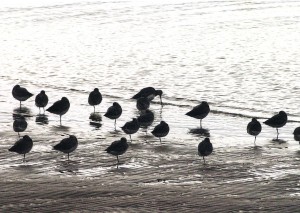 There are many guides to wildlife sites in the Highlands and one of the most useful is an A5 size booklet on birds. It is “The top 52 bird watching sites in the Highlands” published by the RSPB in 2006 and it is still in print. . The various sites were chosen by the Highland Group of the RSPB and as a measure of its success it is the third edition including two new sites and many revisions. Some of the sites are well known such as Loch Fleet in East Sutherland, Handa Island in North – west Sutherland and Loch Maree in Wester Ross. There are four area maps and the sites in and around Inverness are covered by Map 1. The Ness Islands are actually in Inverness whilst others include Munlochy Bay, Fyrish Woods near Evanton and Evanton shore.
There are many guides to wildlife sites in the Highlands and one of the most useful is an A5 size booklet on birds. It is “The top 52 bird watching sites in the Highlands” published by the RSPB in 2006 and it is still in print. . The various sites were chosen by the Highland Group of the RSPB and as a measure of its success it is the third edition including two new sites and many revisions. Some of the sites are well known such as Loch Fleet in East Sutherland, Handa Island in North – west Sutherland and Loch Maree in Wester Ross. There are four area maps and the sites in and around Inverness are covered by Map 1. The Ness Islands are actually in Inverness whilst others include Munlochy Bay, Fyrish Woods near Evanton and Evanton shore.
Travelling to the east from Inverness the sites include Nairn Harbour, Culbin Forest and Findhorn Bay. The site furthest east along the coast is Roseisle Forest near Kinloss and Burghead Bay which is part of the internationally famous Moray Firth. The best views of the bay are from Burghead itself either down by the harbour or by the fort on the headland. At this time of the year this is one of the best places in the Highlands to see sea ducks and divers. The reason that the site is so good for birds and other wildlife is that anything moving along the coast or in and out of the bay has to pass the headland where birds, seals and dolphins often pass close to the shore – line and are therefore easier to see.
One of the best times to visit the site is when the tide is starting to ebb as then the birds are on the move taking advantage of the exposed various types of food such as shellfish. On the north side of the peninsular is a rocky shore line with some rock pools and as the tide retreats the pools are frequented by waders anxious to feed. The birds include godwits, shown in the photograph, redshank, oystercatchers, curlew, turnstones and occasionally purple sandpipers. If the tide is moving then the seabirds will be feeding and the best conditions to see them is when the sea is calm as the birds are more visible. The sea ducks are outstanding with many eider ducks and smaller numbers of common scoters and long tailed ducks The male long tailed ducks with, as the name suggests, their very long tails may be calling and the notes can be likened to “yodelling”. Other birds on the sea include red throated divers, red breasted mergansers and cormorants. Small flocks of all these birds will drift out with the tide and then flight back in again to resume feeding. Boats often come in and out of the harbour and birds will often rise in front of them and then fly back so there is always plenty to see.
If the sea is rough or stormy then many of the birds will be south west of the point in the sheltered parts of the bay and often close in to the shore. In such conditions a few birds such as eiders and goldeneye will rest up actually within the harbour wall where the water is calm. There they can often be seen at close quarters and some of the male eiders may even be displaying with heads thrown back and uttering their rather mournful dove-like cooing calls.
